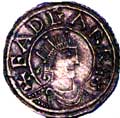 |
Eadgar
b. 943/944
d. 8 Jul 975 (buried at Glastonbury)
|
| Title: |
Rex (King) (see note on royal styles) |
| Term: |
after 9 May 957 - 8 Jul 975 |
| Chronology: |
after 9 May 957, installed as king of the Mercians and Northumbrians |
| |
after 1 Oct 959, acceded in Wessex after the death of his brother, Eadwig |
| |
c. 960, consecrated [?], Kingston-upon-Thames [?] (see note on consecration) |
| |
11 May 973, consecrated, Bath, Somerset (see note on consecration) [1; 2] |
| |
8 Jul 975, died |
| Names/titles: |
In modern English spelled as: Edgar; byname: the Peaceable |
| Biography: |
The younger son of King Edmund, Eadgar was proclaimed king in Mercia and Northumbria (after 9 May 957) during the reign of his brother, Eadwig. Upon the death of Eadwig (1 Oct 959), Eadgar was also recognized as king in Wessex. At the time of his succession Eadgar was about 15 years old and the real government was entrusted to his grandmother, Queen Ædgive. Dunstan was recalled to England and appointed the archbishop of Canterbury after the death of Oda (961). Eadgar encouraged the monastic reforms undertaken by Dunstan and supported the clergy in founding abbeys. A number of secular priests were driven from their sees and were replaced with monks. In 973 Eadgar was consecrated at Bath Abbey. This grandeur ceremony was marked in the Anglo-Saxon Chronicle by a poem and described in Byrhtferth's "Vita Oswaldi". In another ceremony, the Celtic kings acknowledged Edgar's overlordship and rowed him along the river Dee while he held the rudder. Throughout his reign Edgar maintained peace attained by strict control backed up by military force rather than serenity of the king's character. Biography sources: [3][4][5] |
| |
| [1] |
"The Significance of the Regal Consecration of Edgar in 973", by A. Jones in JOURNAL OF ECCLESIASTICAL HISTORY 33 (1982), pp. 375-390. |
| [2] |
"Chapters of English History before the Conquest", by E.W. Robertson, in his Historical Essays in Connexion with the Land, the Church, etc. (1872), pp. 166-215: includes 'The Coronation of Edgar', pp. 203-215. |
| [3] |
"The Blackwell Encyclopædia of Anglo-Saxon England", ed. by Michael Lapidge (Oxford, Blackwell, 1999). |
| [4] |
Handbook of British Chronology (1986) |
| [5] |
"The Anglo-Saxon Chronicle," ed. and trans. by G.N. Garmonsway (Everyman Press, London, 1953, reissued 1972, 1994). |
| |
Image: coin of King Eadgar (obverse legend: +EADGAR R[?]). |

